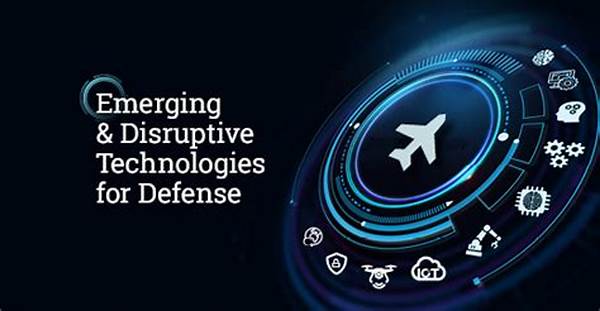In the rapidly evolving landscape of global defense strategies, the integration of emerging technologies represents a pivotal advancement. These technologies offer unprecedented capabilities that can significantly enhance national security and defense operations. The assimilation of cutting-edge tools into military arsenals is crucial for maintaining a strategic edge over potential adversaries. This article delves into the various aspects of emerging defense technology integration, exploring its implications, challenges, and opportunities for modern military forces worldwide.
Impact of Emerging Defense Technology Integration
Emerging defense technology integration has the potential to transform military capabilities on a global scale. Through the incorporation of artificial intelligence, robotics, and cyber defense systems, militaries can achieve superior operational efficiency. These technologies enable faster decision-making, improved situational awareness, and enhanced precision in targeting. For example, drones equipped with advanced AI can perform reconnaissance missions with minimal human intervention, drastically reducing the risk to personnel. Furthermore, integrating cyber defense mechanisms is paramount to safeguarding critical infrastructure from increasingly sophisticated cyber threats. As these technologies continue to advance, the seamless integration of these tools will be instrumental in addressing future conflicts and maintaining geopolitical stability.
However, the integration process is fraught with challenges that need to be strategically managed. One of the primary concerns is the ethical implications surrounding autonomous weapon systems. The deployment of such systems raises questions about accountability and decision-making in combat scenarios. Additionally, the interoperability of new technologies with existing military infrastructure presents logistical obstacles. Militaries must invest in training programs to equip personnel with the necessary skills to operate and maintain these state-of-the-art tools effectively. Despite these challenges, the benefits of emerging defense technology integration outweigh the potential drawbacks, offering a pathway to enhanced national security and military prowess.
Challenges in Emerging Defense Technology Integration
1. Ethical Considerations
Emerging defense technology integration presents ethical dilemmas, particularly with autonomous systems. Questions about accountability, decision-making, and compliance with international laws of war arise.
2. Logistical Interoperability
Integrating new technologies with existing military assets requires complex logistical efforts. Ensuring seamless communication and functionality is a significant challenge in emerging defense technology integration.
3. Training and Skill Development
Effective emerging defense technology integration necessitates comprehensive training programs. Military personnel require new skills to operate and maintain advanced technologies.
4. Cybersecurity Risks
The integration of digital technologies opens new avenues for cyber attacks. Strengthening cybersecurity measures is crucial for protecting sensitive data in emerging defense technology integration.
5. Cost Implications
Emerging defense technology integration can be financially demanding. States must consider budget allocations to facilitate the integration process without compromising other defense needs.
Strategic Benefits of Emerging Defense Technology Integration
Emerging defense technology integration stands as a formidable force multiplier in modern military strategy. With the ability to enhance operational capabilities, nations can deter potential threats more effectively. The integration of autonomous vehicles and UAVs (Unmanned Aerial Vehicles) revolutionizes surveillance and reconnaissance missions, offering real-time data collection with minimal risk to human life. Furthermore, these technologies enable precision strikes that minimize collateral damage in conflict zones. Advanced AI-driven analytics provide better insights, facilitating quicker and more informed decision-making processes.
Moreover, emerging defense technology integration strengthens intelligence and counter-intelligence operations. Cyber defense tools protect against espionage, safeguarding sensitive data from adversaries. Additionally, leveraging big data analytics enables agencies to identify patterns and predict potential threats before they manifest. These strategic benefits collectively provide a significant advantage in the realm of global security. As adversaries continue adapting to technological advancements, staying ahead in the integration of such technologies becomes imperative. The strategic benefits realized through emerging defense technology integration can redefine military prowess in the 21st century.
The Role of International Collaboration
1. Enhancing Cooperation
International collaboration is paramount for successful emerging defense technology integration. Sharing research, technology, and best practices enhances global security standards.
2. Standardization Efforts
Collaborative efforts in emerging defense technology integration involve developing international standards that ensure compatibility and ethical compliance across different nations’ defense systems.
3. Joint Development Initiatives
Emerging defense technology integration can benefit from joint R&D projects, where nations pool resources to develop cutting-edge solutions that meet shared security needs.
4. Innovation Exchange
Collaborating with international partners in emerging defense technology integration fosters innovation exchange, enabling access to diverse perspectives and technological advancements.
5. Collective Cyber Defense
Addressing cybersecurity challenges through collective defense initiatives enhances the resilience of emerging defense technology integration against cyber threats.
6. Training and Joint Exercises
International collaboration in training and joint exercises ensures that all parties involved understand and can effectively implement emerging defense technology integration.
7. Balancing Geopolitical Interests
Collaboration in emerging defense technology integration requires balancing national interests and leveraging diplomacy to align defense objectives.
8. Cross-Border Threat Mitigation
Emerging defense technology integration can address transnational threats, such as terrorism and cybercrime, through collaborative intelligence sharing and joint operations.
9. Regulatory Frameworks
Establishing international regulatory frameworks ensures the ethical use and deployment of technologies in emerging defense technology integration.
10. Conflict Prevention
By promoting dialogue and cooperation, emerging defense technology integration can play a role in conflict prevention and fostering global peace.
National Policy Implications
The integration of emerging defense technologies into national defense policies requires careful consideration of various factors. Policymakers must weigh the benefits against the potential risks associated with their deployment. National defense strategies must incorporate guidelines that govern the use of autonomous systems, ensuring compliance with international humanitarian laws. Moreover, establishing protocols for cybersecurity measures is crucial to protect national interests against cyber threats. Investments in research and development can accelerate innovation, providing military forces with advanced capabilities that ensure tactical superiority. It is imperative for policymakers to engage in collaborations with defense industries to facilitate the seamless integration of these technologies.
Additionally, national policy implications extend to budgeting and resource allocation. Governments must judiciously allocate funds to support the procurement and maintenance of emerging defense technologies without compromising other defense requirements. Policymakers should foster partnerships with international allies, aligning defense strategies to create a formidable collective security framework. Furthermore, public awareness and understanding of these technologies’ implications can foster greater societal acceptance of their integration into defense policies. As nations navigate the complexities of emerging defense technology integration, adaptive policy frameworks will be essential in leveraging these advancements to enhance national security.
Future Prospects in Emerging Defense Technology Integration
In the foreseeable future, emerging defense technology integration will continue to evolve, opening new horizons for military capabilities. Advancements in artificial intelligence, quantum computing, and nanotechnology promise to revolutionize how militaries operate and respond to threats. AI-driven simulations could enhance military training, offering immersive environments that prepare personnel for complex scenarios. The potential of quantum computing to address encryption challenges could redefine cybersecurity measures, safeguarding critical defense systems from evolving cyber threats. As technology advances, synthesized data from various sources can offer enhanced situational awareness, improving strategic military planning.
Moreover, the integration of emerging technologies is expected to result in more efficient and sustainable defense operations. Innovations in materials science could lead to the development of lightweight and durable military equipment, enhancing mobility and reducing resource consumption. The rise of autonomous systems also presents opportunities for reducing human risk in high-stakes military engagements. By incorporating cutting-edge technologies, future defense strategies can balance enhancing national security with ethical considerations. Overall, the dynamic landscape of emerging defense technology integration holds promise for reshaping global defense capabilities, enabling nations to navigate increasingly complex and interconnected security environments effectively.
Conclusion
In conclusion, the landscape of defense operations is undergoing a significant transformation through emerging defense technology integration. The incorporation of advanced tools offers unparalleled advantages in enhancing military capabilities and addressing global security challenges. However, this integration is not without its complexities, posing various ethical, logistical, and policy-related considerations. As nations continue to adapt to technological advancements, strategic collaboration, both domestically and internationally, will be essential in optimizing the benefits of emerging defense technologies. Through comprehensive training and robust regulatory frameworks, militaries can effectively harness these innovations to bolster national security.
Looking ahead, the future of emerging defense technology integration holds immense potential. As military forces worldwide embrace rapid technological advancements, the trajectory of defense operations will be shaped by the continued evolution of AI, cybersecurity, and autonomous systems. It is crucial for policymakers, defense industries, and international partners to collaboratively navigate the challenges and opportunities presented by this integration. By fostering a cooperative environment and establishing a shared commitment to ethical standards, the global community can truly realize the transformative power of emerging defense technologies in ensuring a secure and resilient future.





